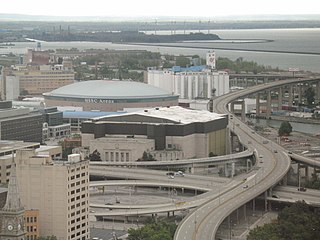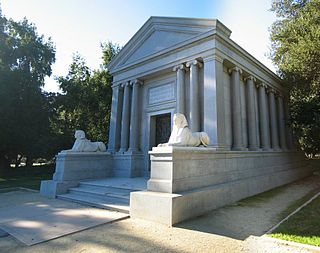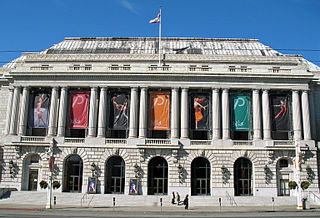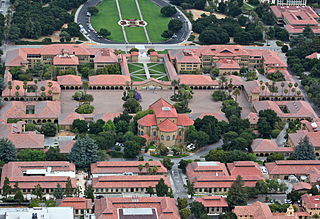
Sproul Plaza is a major center of student activity at the University of California, Berkeley. It is divided into two sections: Upper Sproul and Lower Sproul. They are separated by 12 vertical feet and a set of stairs.

Buffalo Memorial Auditorium was an indoor arena in downtown Buffalo, New York. Opened on October 14, 1940, it hosted the AHL's Buffalo Bisons, the NBL's Buffalo Bisons, the NHL's Buffalo Sabres, the NBA's Buffalo Braves, the MSL's Buffalo Stallions, the MILL's Buffalo Bandits, the second NPSL's Buffalo Blizzard and the RHI's Buffalo Stampede. It also hosted NCAA basketball games as well as events such as concerts, the Ringling Brothers circus and Disney on Ice. The Aud was renovated in 1970 and 1990, and it closed in 1996 after the Sabres', Bandits', and Blizzard's seasons ended. It remained vacant until the city demolished it in 2009.
Arthur Brown Jr. (1874–1957) was an American architect, based in San Francisco and designer of many of its landmarks.

Stanford Memorial Church is located on the Main Quad at the center of the Stanford University campus in Stanford, California, United States. It was built during the American Renaissance by Jane Stanford as a memorial to her husband Leland. Designed by architect Charles A. Coolidge, a student of Henry Hobson Richardson, the church has been called "the University's architectural crown jewel".

The Stanford Mausoleum, located in the Northwest of the Stanford University campus in the Stanford University Arboretum, holds the remains of the university's namesake Leland Stanford, Jr. and his parents Leland and Jane Stanford.

Menlo College is a private college specializing in business and located in Atherton, California.

The War Memorial Opera House is an opera house in San Francisco, California, located on the western side of Van Ness Avenue across from the west side/rear facade of the San Francisco City Hall.

Kaiser Convention Center is a historic, publicly owned multi-purpose building located in Oakland, California. The facility includes a 5,492-seat arena, a large theater, and a large ballroom. The building is #27 on the list of Oakland Historic Landmarks.

The campus of the University of California, Berkeley and its surrounding community are home to a number of notable buildings by early 20th-century campus architect John Galen Howard, his peer Bernard Maybeck, and their colleague Julia Morgan. Later buildings were designed by architects such as Charles Willard Moore and Joseph Esherick.

The San Jose Civic is a former arena, currently operating as a theatre, located in downtown San Jose, California. The venue is owned by the City of San Jose, is managed by Team San Jose and is booked by Nederlander Concerts. The auditorium seats 3,036 which can be expanded up to 3,326 in a general admission setting.

Negoesco Stadium is a 3,000 seat soccer stadium located in San Francisco, on the campus of University of San Francisco. Named for USF Soccer Coach Steve Negoesco. It is the home field for the men's and women's soccer teams. Negoesco is also the primary home field for San Francisco City FC of the Premier Development League. The stadium is also used by USF students and staff for recreational activities.

Braun Music Center is a music education building at Stanford University in California.

The Black Community Services Center, originally known as the Black Student Volunteer Center, was established in 1969 in response to a series of Stanford University events resulting from the assassination of Dr. Martin Luther King, Jr. in 1968. Since then, the primary goals of the BCSC have changed from being a hub of political activity to a center promoting the personal, intellectual, and professional growth of students in the Black community.

The Harding Theater is a historic movie theater located at 616 Divisadero Street in San Francisco, California. The space is currently occupied by the Emporium Arcade Bar.

Worcester Memorial Auditorium is a multi-purpose arena located at Lincoln Square in Worcester, Massachusetts. It was built in 1933 to honor the sacrifices of Worcester citizens during times of war. The building includes a multi-purpose auditorium originally designed to seat 3,500-4,500 people, a smaller entertainment space known as the Little Theater designed to seat 675, and the Shrine of the Immortal, a war memorial with murals by renowned artist Leon Kroll commemorating the 355 soldiers and nurses from Worcester who fell during World War I. The Aud was added to the National Register of Historic Places in 1980 as part of the Institutional District. In 2009, Preservation Massachusetts included Lincoln Square on its "Most Endangered Historic Resources" list, because the square's three historic buildings - the Aud, the old Worcester County Courthouse, and the Lincoln Square Boys Club - were all empty or underutilized.
The Iris & B. Gerald Cantor Center for Visual Arts at Stanford University, formerly the Stanford University Museum of Art, and commonly known as the Cantor Arts Center, is an art museum on the campus of Stanford University in Stanford, California. The museum first opened in 1894 and now consists of over 130,000 square feet of exhibition space, including sculpture gardens. The Cantor Arts Center houses the largest collection of sculptures by Auguste Rodin in an American museum, with 199 works by Rodin, most in bronze but also other media. The museum is open to the public and charges no admission.

McFarlin Memorial Auditorium is a proscenium style theatre located on the campus of Southern Methodist University. The venue seats 2,386 on three levels. The building is the third oldest on SMU's campus and has hosted a number of notable acts.

The Reliance Athletic Club was an athletic club and gentlemen's club founded in 1885 in Oakland, California, United States. Founded in 1885, the organization grew rapidly as it added other sports and social activities, reaching its peak in the mid-1890s before financial troubles led to its bankruptcy and disestablishment in 1910.

The Main Quadrangle, or more commonly Main Quad or simply Quad, is the heart and oldest part of Stanford University in California. The collection of connected buildings was started in 1887 and completed in 1906. The Quad was damaged in the 1906 earthquake, repaired, less severely damaged in an 1989 earthquake, and repaired again. The exteriors have remained almost the same since the beginning, though the interiors of most of the buildings have changed radically. The Main Quad is still used for its original purposes of teaching, research, and administration.
John Bakewell Jr. (1872–1963) was an American architect, based in San Francisco. With Arthur Brown Jr., he formed the architectural firm of Bakewell and Brown, which designed many San Francisco Bay Area landmarks. Following the dissolution of Bakewell and Brown in 1927, Bakewell formed the new partnership of Bakewell & Weihe with longtime employee Ernest Weihe.

















